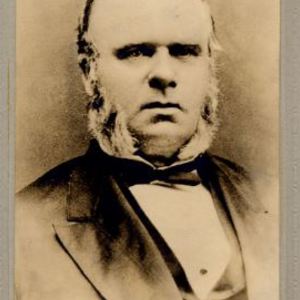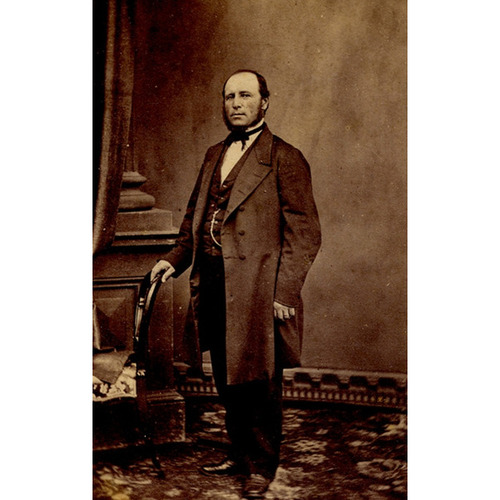As part of the funding agreement between the Dictionary of Canadian Biography and the Canadian Museum of History, we invite readers to take part in a short survey.
![Jean-Baptiste Renaud. Créateur: Livernois Québec. Date: [Vers 1870].
Source: http://numerique.banq.qc.ca/patrimoine/details/52327/3113773
Original title: Jean-Baptiste Renaud. Créateur: Livernois Québec. Date: [Vers 1870].
Source: http://numerique.banq.qc.ca/patrimoine/details/52327/3113773](/bioimages/w600.12998.jpg)
Source: Link
RENAUD, JEAN-BAPTISTE, merchant, businessman, and municipal councillor; b. 22 June 1816 at Lachine, Lower Canada, son of Jean-Baptiste Renaud, a voyageur, and Marie Gariépy; m. 18 Jan. 1841 Marie-Sophie Lefebvre at Montreal, and they had four children; d. 1 March 1884 in Quebec City.
Jean-Baptiste Renaud was of humble origin and soon gave up primary school to help his ailing father provide for the family. He started out as a carter in Montreal, where his brother Louis* soon joined him. The two were married on the same day in the parish of Notre-Dame in Montreal and the marriage certificates describe each as a “carter.” About 1847, in Montreal, Louis Renaud began to trade in grain, flour, and perhaps also general foodstuffs. The following year he went into partnership with his brother to open a store on Rue Foundling. Louis, whose name appeared in the firm’s designation of L. Renaud and Brother, seems to have been the leader in it.
Around 1850 Jean-Baptiste Renaud went to live in Quebec City, on Rue Sainte-Famine. The Quebec directory of 1850–51 mentions the firm of L. Renaud and Brother, produce merchants. The firm underwent changes towards the end of the 1850s, since the 1857–58 directory mentions only Jean-Baptiste Renaud, “provision merchant.” At that time he was dealing in grain, flour, fish, and probably oils. During this period Renaud built the largest flour-mill in the Quebec region, at Beauport, as well as two smaller ones where “barley and split peas of superior quality” were processed. He also acquired a number of schooners for trade with the villages along the St Lawrence.
Operating at the heart of the region’s commercial life, Renaud was aware that the prosperity of his business depended on the development of means of transport which would link Quebec to its hinterland. He believed that railways would provide the answer. His name was listed as a director of the North Shore Railway Company [see Guillaume-Eugène Chinic] in 1857 and 1858. However, as the company became increasingly bogged down in interminable discussions and dubious political deals, Renaud, while not completely giving up his interest in railways, turned to shipping. Thus he took part in the incorporation of both the St Maurice Railway and Navigation Company and the Salaberry Navigation Company of Montreal in 1857, and the St Lawrence Navigation Company in 1861. His business and shipping interests naturally led him into other economic sectors. In 1862 he had a hand in the incorporation of the Quebec Marine Insurance Company. It is not known whether he was involved in the founding of the Union Bank of Lower Canada, incorporated with a capital of two million dollars in 1865 by a group of businessmen under the leadership of Charles E. Levey, but the Quebec City directory of 1871–72 lists him as one of its directors.
The 1860s were a period of social ascent for Renaud. He was a member of the Quebec Board of Trade in 1862 and sat on city council from 1862 to 1868 as representative for Saint-Pierre Ward. Far from giving up his interest in the development of means of communication, he was on the board of directors of the Quebec North Shore Turnpike Roads Company from 1866 to 1871. It is possible that the diversification of his portfolio led him in 1871 to reorganize his business interests. The Quebec directory of 1871–72 noted a new firm name, J.-B. Renaud and Company, and that of 1879–80 mentions his son Jean-Louis Renaud, Gaspard Le Moine, and Victor Chateauvert as among his partners. Shortly after, Le Moine and Chateauvert purchased the firm of J.-B. Renaud; it is not known, however, whether the new owners managed the Beauport mills. This reorganization of the company freed Renaud from a heavy burden and gave him time to concentrate even more on enterprises which he was already managing, as well as capital to embark on new ventures. At the beginning of the 1870s many Quebec businessmen were looking to the Lac Saint-Jean region as a promised land; among those interested were the directors of the Union Bank of Lower Canada and its vice-president Thomas McGreevy*, a railway contractor. Renaud also expressed enthusiasm for the development of this region and was eager for a railway to be built to link it with Quebec. In 1872–73 he was a member of the board of directors of the Quebec and Gosford Railway Company, which built an initial section from Quebec to Portneuf County, and he returned to the board in 1875 when the company became the Quebec and Lake St John Railway Company, retaining his directorship until 1877. Presumably, as a director of the Union Bank from 1871 to 1878, he represented its interests. While the railway to Lac Saint-Jean was still under construction, Quebec capitalists were already preparing to exploit this hinterland to the best advantage. In 1877, along with other businessmen, Renaud organized the Quebec and Lake St John Lumbering and Trading Company, of which he remained a director for the rest of his life.
In the absence of an analysis of his accounting records it is not known how Renaud weathered the severe economic depression that paralysed commerce from 1874 to 1878. On 12 June 1878 his warehouses are known to have been looted by strikers from the Quebec building yards, who unsuccessfully demanded higher wages; Le Journal de Québec on 13 June estimated that Renaud, who had not been afraid to harangue the strikers, had sustained losses of $2,000 (150 sacks of flour and 200 barrels). Ostensibly at least, he emerged from this crisis with undiminished energies. In 1878, perhaps taking advantage of the bankruptcies that had shaken business at Quebec, he opened an establishment specializing in “stoneware and earthenware” at 24 Rue Saint-Paul. This firm still exists under the name of “J.-B. Renaud & Cie” (Renaud’s first milling business also continues, having moved its head office to Rivière-du-Loup in the 20th century). During the 1880s Renaud retained his interest in shipping. In 1882 he became a director of the Richelieu and Ontario Navigation Company [see Hugh Allan; Louis-Adélard Senécal]. This appointment was not surprising since close ties were maintained between the Union Bank, the Richelieu and Ontario Navigation Company, and the St Lawrence Navigation Company.
Having a flair for speculation, Renaud took advantage of the urban development of Quebec City and the neighbouring towns to make profitable investments throughout his life. He gradually became an important landowner. In addition to his warehouses and docks in Quebec City and his 33-acre estate at Beauport, he owned 7 other properties in the city (one, in Saint-Sauveur, was subdivided in 1884 into 233 lots) and 39 at Lévis and Lauzon; he also owned one building in Quebec City and one in Lévis, and held another at Rivière-du-Loup jointly with his partners Le Moine and Chateauvert.
At the beginning of the 1880s Renaud had become one of the principal French-speaking businessmen because of the volume of his investments and the diversity of his transactions. He maintained connections with English-speaking financial circles and with the world of politics, as is evidenced by his purchase of the Conservative paper La Minerve, with Joseph Tassé*, Alexandre Lacoste*, and Aimé Gélinas, on 30 Aug. 1880. But he always refused to run in provincial and federal elections on the pretext that he lacked the necessary education. While still fully active, he died suddenly, on 1 March 1884, without having carried out a project to which he was deeply attached: the building of a bridge between Cap-Rouge and Saint-Nicolas. As well as praising him for his honesty and drive, the obituary in Le Courrier du Canada stressed “his practical knowledge of men and of things, [and] the soundness of his judgement.”
Renaud’s death did not terminate his business, which continued to thrive under the skilful direction of his partners Le Moine and Chateauvert. In 1912 the firm of J.-B. Renaud had an annual volume of sales of $3,000,000, with 130 employees and 8 commercial travellers.
ANQ-M, État civil, Catholiques, Notre-Dame de Montréal, 18 janv. 1841; Saints-Anges (Lachine), 23 juin 1816. ANQ-Q, Minutiers, Édouard Glackmeyer, 4 mai, 30 juill. 1875. AVQ, Rôles d’évaluation et d’imposition, 1871. BE, Québec, Reg. B, 145, no.69273. Musée d’Odanak (Odanak, Qué.), Fonds divers, Boîte 1, 30–39; Boîte 2, 32, 39–47; Boîte 7, 2. Can., Prov. du, Statuts, 1862, c.71. Qué., Statuts, 1884, c.91; 1886, c.92. Le Courrier du Canada, 3 mars 1884. Le Journal de Québec, 13 juin 1878. Annuaire du commerce et de l’industrie de Québec, J.-C. Langelier, compil. (Québec, 1873). Beaulieu et J. Hamelin, La presse québécoise, I: 57. Quebec directory, 1850–84. Rumilly, Hist. de Montréal, III: 102. B. J. Young, Promoters and politicians: the North-Shore railways in the history of Quebec, 1854–85 (Toronto, 1978). É.-Z. Massicotte, “Deux grands négociants,” BRH, 42 (1936): 339–40.
Cite This Article
In collaboration with Jean Hamelin, “RENAUD, JEAN-BAPTISTE,” in Dictionary of Canadian Biography, vol. 11, University of Toronto/Université Laval, 2003–, accessed March 29, 2025, https://www.biographi.ca/en/bio/renaud_jean_baptiste_11E.html.
The citation above shows the format for footnotes and endnotes according to the Chicago manual of style (16th edition). Information to be used in other citation formats:
| Permalink: | https://www.biographi.ca/en/bio/renaud_jean_baptiste_11E.html |
| Author of Article: | In collaboration with Jean Hamelin |
| Title of Article: | RENAUD, JEAN-BAPTISTE |
| Publication Name: | Dictionary of Canadian Biography, vol. 11 |
| Publisher: | University of Toronto/Université Laval |
| Year of revision: | 1982 |
| Access Date: | March 29, 2025 |




